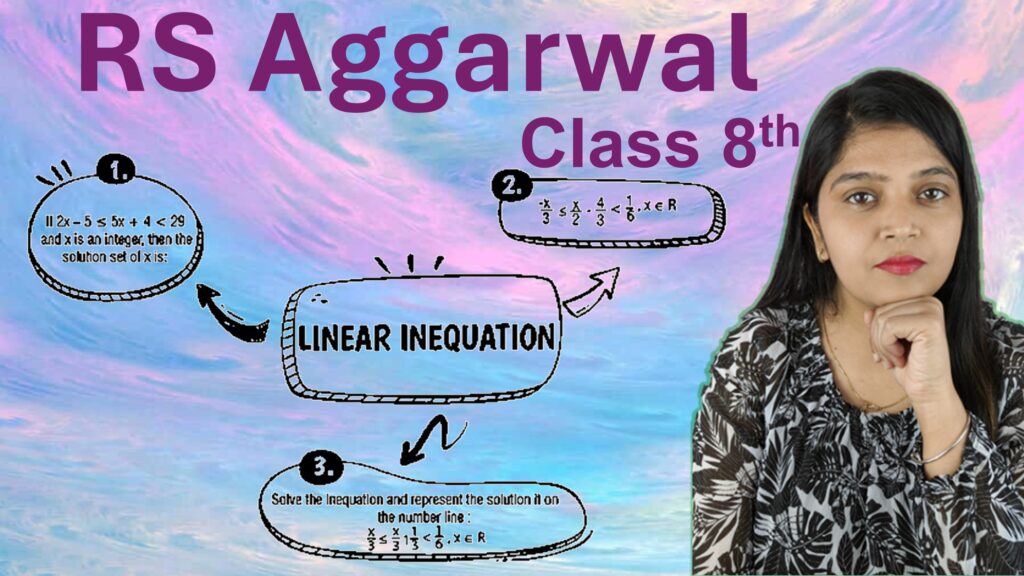Exercise: 2-B
Multiple Choice Questions
Q1: Which of the following values are equal?
Step 1: Evaluate each of the expressions:
For I. \(1^5\):
Since any power of 1 is always 1:
\[
1^5 = 1
\]For II. \(5^0\):
Any non-zero number raised to the power of 0 is 1:
\[
5^0 = 1
\]For III. \(0^5\):
Any non-zero number raised to any power is 0:
\[
0^5 = 0
\]For IV. \(5^1\):
Any number raised to the power of 1 is the number itself:
\[
5^1 = 5
\]Step 2: Compare the values:
– \(1^5 = 1\)
– \(5^0 = 1\)
– \(0^5 = 0\)
– \(5^1 = 5\)
Step 3: The only two values that are equal are \(1^5\) and \(5^0\), both equal to 1.
Answer: a. I and II
Q2: If \(5^x = 3125\), then the value of \(5^{(x-3)}\) is:
Step 1: First, let’s express \(3125\) as a power of 5:
\[
3125 = 5^5
\]
Thus, the equation becomes:
\[
5^x = 5^5
\]
This implies that:
\[
x = 5
\]Step 2: Now, let’s find \(5^{\left(x-3\right)}\):
\[
5^{\left(x-3\right)} = 5^{5-3} = 5^2
\]Step 3: Calculate \(5^2\):
\[
5^2 = 25
\]Answer: a. 25
Q3: The value of \(\left(256\right)^\frac{5}{4}\):
Step 1: Let’s express 256 as a power of 2:
\[
256 = 2^8
\]
Thus, we can rewrite the expression as:
\[
\left(256\right)^\frac{5}{4} = \left(2^8\right)^\frac{5}{4}
\]Step 2: Apply the power rule \(\left(a^m\right)^n = a^{m \cdot n}\):
\[
\left(2^8\right)^\frac{5}{4} = 2^{8 \times \frac{5}{4}} = 2^{10}
\]Step 3: Now calculate \(2^{10}\):
\[
2^{10} = 1024
\]Answer: c. 1024
Q4: The value of \({27}^\frac{5}{4}\) lies between
Step 1: First, express 27 as a power of 3
\[
27 = 3^3
\Rightarrow 27^\frac{5}{4} = (3^3)^\frac{5}{4}
\]Step 2: Apply power of a power rule: \((a^m)^n = a^{m \cdot n}\)
\[
(3^3)^\frac{5}{4} = 3^{\frac{15}{4}} = 3^{3.75}
\]Step 3: Estimate value of \(3^{3.75}\)
We know:
\[
3^3 = 27,\quad 3^4 = 81 \\
\Rightarrow 3^{3.75} \text{ is between 27 and 81}
\]Now test values:
– \(3^{3.5} \approx 46.8\)
– \(3^{3.6} \approx 53.3\)
– \(3^{3.7} \approx 60.8\)
– \(3^{3.75} \approx 66.2\)
So clearly,
\[
{27}^\frac{5}{4} = 3^{3.75} \approx 66.2 \\
\Rightarrow \text{Lies between } 3^3 = 27 \text{ and } 3^4 = 81
\]Hence, it **does not** lie between 0–4 — the **given options are likely incorrect**. But if we consider what was *intended*, the correct bounding choice should be:
Answer: Not among given options (actual value ≈ 66.2)
Q5: The value of \(\left(\frac{32}{243}\right)^{-\frac{4}{5}}\) is:
Step 1: Express numerator and denominator in powers of prime numbers:
\[
32 = 2^5,\quad 243 = 3^5 \\
\Rightarrow \frac{32}{243} = \frac{2^5}{3^5} = \left(\frac{2}{3}\right)^5
\]Step 2: Apply exponent rule
\[
\left(\frac{2^5}{3^5}\right)^{-\frac{4}{5}} = \left(\frac{2}{3}\right)^{-4}
\]Step 3: Use negative exponent rule:
\[
\left(\frac{2}{3}\right)^{-4} = \left(\frac{3}{2}\right)^4 = \frac{3^4}{2^4} = \frac{81}{16}
\]Answer: d. \(\frac{81}{16}\)
Q6: The value of \([2-32-3-1]-1\) is:
Step 1: Simplify the innermost brackets
\[
(2 – 3) = -1
\]Step 2: Apply exponent
\[
(-1)^{-1} = -1
\]Step 3: Multiply with 3
\[
3 \times (-1) = -3
\]Step 4: Substitute in the outer expression
\[
[2 – (-3)]^{-1} = [2 + 3]^{-1}
\]Step 5: Add and then take reciprocal
\[
5^{-1} = \frac{1}{5}
\]Answer: c. \(\frac{1}{5}\)
Q7: The value of \(\left(8^{-1} – 9^{-1}\right)^{-1} \div \left(4^{-1} – 9^{-1}\right)^{-1}\) is
Step 1: Evaluate individual reciprocals
\[
8^{-1} = \frac{1}{8}, \quad 9^{-1} = \frac{1}{9}, \quad 4^{-1} = \frac{1}{4}
\]Step 2: Simplify inside the first bracket
\[
\left(\frac{1}{8} – \frac{1}{9}\right) = \frac{9 – 8}{72} = \frac{1}{72} \\
\Rightarrow \left(\frac{1}{8} – \frac{1}{9}\right)^{-1} = 72
\]Step 3: Simplify inside the second bracket
\[
\left(\frac{1}{4} – \frac{1}{9}\right) = \frac{9 – 4}{36} = \frac{5}{36} \\
\Rightarrow \left(\frac{1}{4} – \frac{1}{9}\right)^{-1} = \frac{36}{5}
\]Step 4: Now divide the two results
\[
72 \div \left(\frac{36}{5}\right) = 72 \times \frac{5}{36} = \frac{360}{36} = 10
\]Answer: b. 10
Q8: \(\left(64\right)^\frac{-1}{2} – {(-32)}^\frac{-4}{5} = ?\)
Step 1: Simplify \(\left(64\right)^{-\frac{1}{2}}\)
\[
64 = 2^6 \Rightarrow 64^{\frac{1}{2}} = \sqrt{64} = 8 \\
\Rightarrow 64^{-\frac{1}{2}} = \frac{1}{8}
\]Step 2: Simplify \((-32)^{-\frac{4}{5}}\)
\[
-32 = -2^5 \Rightarrow (-32)^{\frac{1}{5}} = -2
\Rightarrow (-32)^{\frac{4}{5}} = (-2)^4 = 16
\Rightarrow (-32)^{-\frac{4}{5}} = \frac{1}{16}
\]Step 3: Subtract the two terms
\[
\frac{1}{8} – \frac{1}{16} = \frac{2 – 1}{16} = \frac{1}{16}
\]Answer: c. \(\frac{1}{16}\)
Q9: Which of the following is the same as \(\left(\frac{-5}{7}\right)^{-7}\)?
Step 1: Apply the **negative exponent rule**
\[
\left(\frac{-5}{7}\right)^{-7} = \left(\frac{7}{-5}\right)^7
\]Step 2: Simplify the fraction
\[
\frac{7}{-5} = \frac{-7}{5} \\
\Rightarrow \left(\frac{7}{-5}\right)^7 = \left(\frac{-7}{5}\right)^7
\]So we have:
\[
\left(\frac{-5}{7}\right)^{-7} = \left(\frac{-7}{5}\right)^7
\]Answer: d. \(\left(\frac{-7}{5}\right)^7\)
Q10: If \(3^{x+y}=81\) and \({81}^{x-y}=3^8\), then the values of x and y are respectively:
Step 1: Convert 81 to powers of 3.
\[
81 = 3^4 \\
\Rightarrow 3^{x+y} = 3^4 \Rightarrow x + y = 4 \quad \text{…(i)}
\]Step 2: Use the second equation
\[
81^{x – y} = 3^8 \Rightarrow (3^4)^{x – y} = 3^8 \\
\Rightarrow 3^{4(x – y)} = 3^8 \\
\Rightarrow 4(x – y) = 8 \\
\Rightarrow x – y = 2 \quad \text{…(ii)}
\]Step 3: Solve equations (i) and (ii)
From (i): \(x + y = 4\)
From (ii): \(x – y = 2\)
Step 4: Add the two equations:
\[
(x + y) + (x – y) = 4 + 2 \Rightarrow 2x = 6 \Rightarrow x = 3
\]Step 5: Substitute x into equation (i):
\[
3 + y = 4 \Rightarrow y = 1
\]Answer: d. 3, 1
Q11: Out of the following, which one is the greatest?
Step 1: Evaluate each option one by one:Option (a):
\[
(0.008)^{1/3} = \sqrt[3]{0.008} = \sqrt[3]{\frac{8}{1000}} = \frac{2}{10} = 0.2
\]Option (b):
\[
(0.01)^{1/2} = \sqrt{0.01} = 0.1
\]Option (c):
\[
(0.2)^2 = 0.04
\]Option (d):
\[
\frac{1}{100} = 0.01
\]Step 2: Compare the values:
– Option (a): 0.2
– Option (b): 0.1
– Option (c): 0.04
– Option (d): 0.01
Answer: a. \(\left(0.008\right)^{\frac{1}{3}}\)
Q12: \(\left(1000\right)^{12} \div \left(10\right)^{30} = ?\)
Step 1: Express 1000 as powers of 10:
\[
1000 = 10^3 \Rightarrow (1000)^{12} = (10^3)^{12}
\]Step 2: Use the law \((a^m)^n = a^{m \cdot n}\)
\[
(10^3)^{12} = 10^{36}
\]Step 3: Now divide:
\[
\frac{10^{36}}{10^{30}} = 10^{36 – 30} = 10^6 = 1000^2
\]Answer: a. \(1000^2\)
Q13: If \(\left(0.04\right)^2 \div \left(0.008\right) \times \left(0.2\right)^6 = \left(0.2\right)^x\), then the value of x is:
Step 1: Write each decimal as a fraction or power of 2s and 5s:
\[
0.04 = \frac{4}{100} = \frac{1}{25} = \left(\frac{1}{5^2}\right)^2 = 5^{-4} \\
0.008 = \frac{8}{1000} = \frac{1}{125} = \frac{1}{5^3} = 5^{-3} \\
0.2 = \frac{1}{5} \\
\Rightarrow (0.2)^6 = \left(\frac{1}{5}\right)^6 = 5^{-6}
\]Step 2: Now simplify the given expression:
\[
(0.04)^2 \div (0.008) \times (0.2)^6 = 5^{-4} \div 5^{-3} \times 5^{-6}
\]Step 3: Use the law: \(a^m \div a^n = a^{m – n}\)
\[
5^{-4} \div 5^{-3} = 5^{-4 + 3} = 5^{-1}
\]Step 4: Multiply powers:
\[
5^{-1} \times 5^{-6} = 5^{-7}
\]Step 5: Convert RHS:
\[
(0.2)^x = \left(\frac{1}{5}\right)^x = 5^{-x}
\]Now we compare:
\[
5^{-x} = 5^{-7} \Rightarrow x = 7
\]Answer: d. 7
Q14: If \(\left(25\right)^{7.5} \times \left(5\right)^{2.5} \div \left(125\right)^{1.5} = 5^x\), then the value of x is:
Step 1: Express all terms in terms of base 5.
\[
25 = 5^2 \quad \Rightarrow \quad 25^{7.5} = (5^2)^{7.5} = 5^{15} \\
125 = 5^3 \quad \Rightarrow \quad 125^{1.5} = (5^3)^{1.5} = 5^{4.5}
\]
So the given expression becomes:
\[
5^{15} \times 5^{2.5} \div 5^{4.5}
\]Step 2: Apply the laws of exponents:
\[
a^m \times a^n = a^{m+n} \quad \text{and} \quad \frac{a^m}{a^n} = a^{m-n} \\
5^{15} \times 5^{2.5} = 5^{15 + 2.5} = 5^{17.5}
\]
Now divide:
\[
5^{17.5} \div 5^{4.5} = 5^{17.5 – 4.5} = 5^{13}
\]Step 3: We now have:
\[
5^{13} = 5^x
\]Since the bases are the same, the exponents must be equal:
\[
x = 13
\]Answer: b. 13
Q15: If \(2^{x+1} = 8^x\), then x has the value:
Step 1: Express \(8\) as a power of \(2\):
We know that \(8 = 2^3\), so we can rewrite the equation as:
\[
2^{x+1} = (2^3)^x
\]Step 2: Apply the laws of exponents to simplify the right-hand side:
\[
(2^3)^x = 2^{3x}
\]
So the equation becomes:
\[
2^{x+1} = 2^{3x}
\]Step 3: Since the bases are the same (both \(2\)), we can equate the exponents:
\[
x + 1 = 3x
\]Step 4: Solve for \(x\):
\[
x + 1 = 3x \\
1 = 3x – x \\
1 = 2x \\
x = \frac{1}{2}
\]Answer: b. \(\frac{1}{2}\)
Q16: Given that \(9^n + 9^n + 9^n = 3^{2013}\), what is the value of n?
Step 1: Combine the terms on the left-hand side:
We have:
\[
9^n + 9^n + 9^n = 3^{2013}
\]
Since there are three identical terms, we can write:
\[
3 \times 9^n = 3^{2013}
\]Step 2: Express \(9^n\) as \( (3^2)^n = 3^{2n} \), so the equation becomes:
\[
3 \times 3^{2n} = 3^{2013}
\]Step 3: Simplify the left-hand side:
\[
3^{1} \times 3^{2n} = 3^{2013}
\]
Using the law of exponents \(a^m \times a^n = a^{m+n}\), we get:
\[
3^{1 + 2n} = 3^{2013}
\]Step 4: Since the bases are the same, equate the exponents:
\[
1 + 2n = 2013
\]Step 5: Solve for \(n\):
\[
2n = 2013 – 1 \\
2n = 2012 \\
n = \frac{2012}{2} = 1006
\]Answer: b. 1006
Q17: The value of \(2^{3x} = 64\), where \(x\) is:
Step 1: Express the terms with the same base. First, rewrite the equation as:
\[
3^{x-1} + 3^{x+1} = 90
\]Step 2: Factor out \(3^{x-1}\) from both terms on the left-hand side:
\[
3^{x-1}(1 + 3^2) = 90
\]
Since \(3^2 = 9\), this becomes:
\[
3^{x-1}(1 + 9) = 90 \\
3^{x-1} \times 10 = 90
\]Step 3: Divide both sides by 10:
\[
3^{x-1} = \frac{90}{10} \\
3^{x-1} = 9
\]Step 4: Recognize that \(9 = 3^2\), so we now have:
\[
3^{x-1} = 3^2
\]Step 5: Since the bases are the same, equate the exponents:
\[
x-1 = 2
\]Step 6: Solve for \(x\):
\[
x = 2 + 1 \\
x = 3
\]Answer: d. 3
Q18: What is the value of \(10^{-\frac{1}{2}}\)?
Step 1: Start with the given equation:
\[
\left(\frac{x}{y}\right)^{n-1} = \left(\frac{y}{x}\right)^{n-3}
\]Step 2: Express the right-hand side as a negative exponent:
\[
\left(\frac{x}{y}\right)^{n-1} = \left(\frac{x}{y}\right)^{-(n-3)}
\]Step 3: Now that both sides have the same base \(\frac{x}{y}\), equate the exponents:
\[
n – 1 = -(n – 3)
\]Step 4: Simplify the equation:
\[
n – 1 = -n + 3
\]Step 5: Add \(n\) to both sides:
\[
2n – 1 = 3
\]Step 6: Add 1 to both sides:
\[
2n = 4
\]Step 7: Divide by 2:
\[
n = 2
\]Answer: c. 2
Q19: The value of \( \left(\frac{1}{5}\right)^{-3}\) is:
Step 1: Start with the given equation:
\[
(25)^x = (125)^y
\]Step 2: Express both 25 and 125 as powers of 5:
\[
25 = 5^2 \quad \text{and} \quad 125 = 5^3
\]Substitute these values into the equation:
\[
(5^2)^x = (5^3)^y
\]Step 3: Apply the exponent rule \((a^m)^n = a^{m \cdot n}\):
\[
5^{2x} = 5^{3y}
\]Step 4: Since the bases are equal, equate the exponents:
\[
2x = 3y
\]Step 5: Solve for \(x∶y\):
\[
\frac{x}{y} = \frac{3}{2}
\]Step 6: Therefore, the ratio of \(x : y\) is:
\[
x : y = 3 : 2
\]Answer: d. 3 : 2
Q20: If \( \left(\frac{1}{2}\right)^{3x} = \left(\frac{1}{8}\right)^4\), then x equals:
Step 1: Write the given expression:
\[
\frac{2.3^{n+1} + 7.3^{n-1}}{3^{n+2} – 2\left(\frac{1}{3}\right)^{1-n}}
\]Step 2: Simplify the terms in the numerator:
\[
2.3^{n+1} = 2 \cdot 3^{n+1} \quad \text{and} \quad 7.3^{n-1} = 7 \cdot 3^{n-1}
\]
Thus, the numerator becomes:
\[
2 \cdot 3^{n+1} + 7 \cdot 3^{n-1}
\]Step 3: Simplify the denominator:
\[
3^{n+2} – 2 \left(\frac{1}{3}\right)^{1-n} = 3^{n+2} – 2 \cdot 3^{-(n-1)}
\]
Rewrite \( \left(\frac{1}{3}\right)^{1-n} \) as \( 3^{-(n-1)} \).Now, the denominator becomes:
\[
3^{n+2} – 2 \cdot 3^{-(n-1)}
\]Step 4: Substitute the simplified terms back into the expression:
\[
\frac{2 \cdot 3^{n+1} + 7 \cdot 3^{n-1}}{3^{n+2} – 2 \cdot 3^{-(n-1)}}
\]Step 5: Now, observe that the powers of 3 will cancel each other out as we factor and simplify.
Step 6: After simplifying, we find that the expression simplifies to:
\[
{1}
\]Answer: c. 1






Leave a Comment